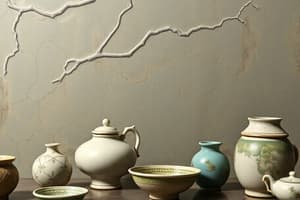Podcast
Questions and Answers
What are the key structural components of ceramic materials?
What are the key structural components of ceramic materials?
Crystalline and amorphous phases
Define the term 'Vitreous Transition' in the context of ceramics.
Define the term 'Vitreous Transition' in the context of ceramics.
The temperature range where a glass transitions from a supercooled liquid to a crystalline solid
What are the rheological properties of glasses?
What are the rheological properties of glasses?
Viscosity and flow behavior
What is the significance of Refractory Technology in ceramics?
What is the significance of Refractory Technology in ceramics?
Name a type of product classified under Whitewares.
Name a type of product classified under Whitewares.
What is the market size of the ceramics industry?
What is the market size of the ceramics industry?
What are the fundamental principles of silicate structure?
What are the fundamental principles of silicate structure?
Explain the Vitreous transition in glasses.
Explain the Vitreous transition in glasses.
List some refractory raw materials and their properties.
List some refractory raw materials and their properties.
What is the significance of fluxes in ceramic materials?
What is the significance of fluxes in ceramic materials?
How are clay minerals classified and what is their structural composition?
How are clay minerals classified and what is their structural composition?
Discuss the applications of synthetic ceramic powder in the industry.
Discuss the applications of synthetic ceramic powder in the industry.
What are the main objectives of introducing students to engineering ceramics?
What are the main objectives of introducing students to engineering ceramics?
Explain the importance of the refractory industry.
Explain the importance of the refractory industry.
What are the characteristics of Whitewares products?
What are the characteristics of Whitewares products?
Describe the classification of refractories based on their composition.
Describe the classification of refractories based on their composition.
What is the significance of understanding the sintering process in Whitewares production?
What is the significance of understanding the sintering process in Whitewares production?
Explain the Dielectric Properties in Advanced and Electro-Ceramics.
Explain the Dielectric Properties in Advanced and Electro-Ceramics.
Flashcards are hidden until you start studying




